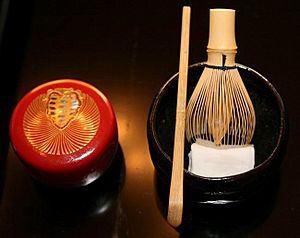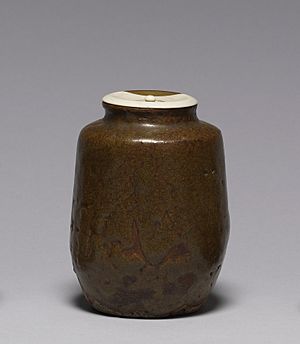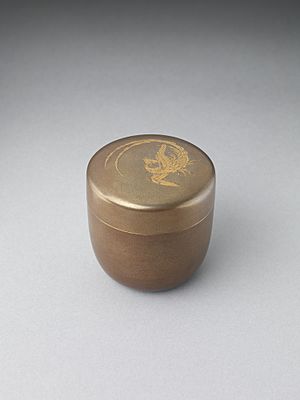Chaki facts for kids
Chaki (茶器) is a Japanese word that means "tea tool." In the world of the Japanese tea ceremony, it can mean any tool used. But more often, it refers to the special container that holds the powdered green tea, called matcha. This article will focus on chaki as these tea containers.
These chaki containers are usually small with lids. They are not for long-term storage. When preparing for a tea ceremony, the host carefully picks the chaki for the matcha. They then neatly place the tea inside it. The chaki is chosen to match the other items used for the ceremony. Guests often pay close attention to the chaki because it is so important.
Chaki are sorted by what they are made of and their shape. They are also sorted by the type of tea they are used for: thin tea or thick tea.
Contents
What Are the Main Types of Chaki?
Chaki can be put into two main groups: those made of ceramic and those made of wood or bamboo.
Ceramic chaki are usually for making thick tea (koicha). These are called chaire (茶入, meaning "tea container") or koicha-ki (濃茶器; "tool for thick tea").
Wood or bamboo chaki are typically for making thin tea (usucha). They are called usucha-ki (薄茶器), or often shortened to usuki. Many of these have a shape called natsume (棗, meaning "jujube fruit"). Because of this, usucha-ki are often just called natsume.
Both chaire and natsume are further sorted. This can be by where they came from, what they are made of, or their shape. Sometimes, they are even named after the potter who made them.
What is an Usucha-ki or Natsume?

An usucha-ki is a wooden container with a lid. It is designed to hold powdered tea for making thin tea. Traditionally, usucha-ki are carved by hand from wood or bamboo. They are usually covered in lacquer. They might also have designs painted, added, or carved onto them. Techniques like maki-e (gold powder in lacquer) or raden (mother-of-pearl inlay) are used. Today, you can also find cheaper usucha-ki made from plastic.
The name natsume comes from the jujube fruit. Some usucha-ki are said to look like this fruit. Strictly speaking, natsume should only describe containers with a slightly rounded top and a body that gets narrower towards the bottom. However, in everyday use, any usucha-ki might be called a natsume.
Since natsume are used for thin tea, they are often the first chaki that someone learning the tea ceremony learns to use.
History of Natsume
A lacquer artist named Haneda Gorō is believed to have created this style of tea container. He lived during the time of the Higashiyama culture. At first, these containers were usually black-lacquered. Records show that Sen no Rikyū, a very famous tea master, used natsume. In his time, natsume were even used for koicha (thick tea).
Different Kinds of Natsume
The most basic type is the "Rikyū shape" (利休形 Rikyū-gata). This comes in three sizes: large (大棗 ō-natsume), medium (中棗 chū-natsume), and small (小棗 ko-natsume). The classic Rikyū-gata natsume is usually plain black lacquer inside and out. Its lid fits onto the body about 7/10 of the way up from the bottom.
There are many other types and sizes of natsume. For example, the flat type (平棗 hira-natsume) is usually about twice as wide as it is tall.
Koma (独楽) is the Japanese word for a spinning top. This design, originally from Southeast Asia, became a popular pattern on natsume.
What is a Chaire?
The most important pottery of the Cha-no-yu is first the Cha-ire and then the Cha-wan. It is said that among the military class the most precious possessions were first Tea-caddies, second writings and third swords. For this was the order in which they were presented by the Shogun to one he desired to honour.
—A. L. Sadler.
The term chaire usually means a small ceramic jar with a lid. It is used to hold powdered tea for making thick tea (koicha). The lid is traditionally made from elephant ivory with a gold leafed underside. However, today, lids are usually made from other materials that look like ivory.
History of Chaire
According to A. L. Sadler, chaire were first used in China during the Song Dynasty. They were bottles for oil or medicine. These bottles were brought to Japan and used as tea caddies until the end of the Ashikaga shogunate or the start of the Edo period.
Different Kinds of Chaire
Chaire can be divided into two main types: karamono and wamono. Karamono are chaire that came from China or look like those made in China. Wamono are those that were made in Japan. These types can be further sorted by the kiln (where they were made) or the potter, as well as their shape.
Karamono Chaire (Chinese Style)
Karamono chaire are sorted by their shape:
- Nasu (茄子): This "eggplant" chaire is a medium-sized container named for its shape, which looks like an aubergine.
- Bunrin (文琳): This chaire has an "apple" shape.
- Katatsuki' (肩衝): This is a very common type. It's called the "protruding shoulder" chaire because it has clear "shoulders" near the top.
- Marutsubo (丸壺): This means "round jar" shape.
- Taikai (大海): This is the "big ocean" chaire. It is quite wide and has a wide opening compared to its height.
Wamono Chaire (Japanese Style)
Wamono chaire are sorted by the names of the kilns (places where pottery is made) and potters. The kilns in Seto (in what is now Aichi Prefecture) are thought to be the first Japanese kilns to make chaire. So, chaire from Seto kilns are not usually called "provincial ware." Also, the various kilns in Kyoto are not seen as "provincial ware."
Provincial Ware (kuniyakimono)
These are chaire from other regions of Japan. Some examples include:
- Karatsu ware
- Satsuma ware
- Shigaraki ware
- Takatori ware
- Bizen ware





